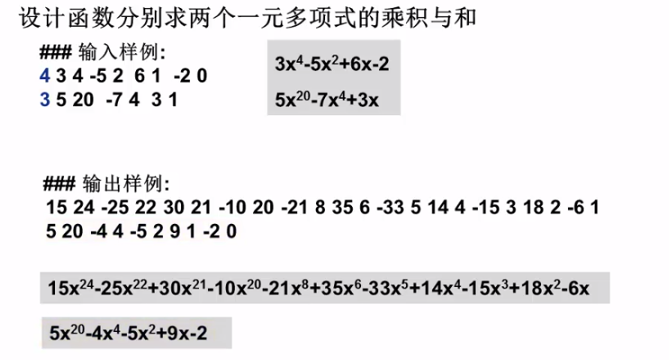多项式的表示可以使用数组也可以使用链表
- 数组表示起来简单,调试方便。但需要事先确定数组的大小。
- 链表表示起来动态性强,但编程复杂,调试起来困难。
为了提高对链表的操作,后面介绍的程序,均使用链表来完成。

注意:下列链表没有头节点
//多项式的加法和乘法
#define _CRT_SECURE_NO_WARNINGS
#include<stdio.h>
#include<stdlib.h>
struct PolyNode
{
int Coef;
int Expon;
struct PolyNode* Next; //指向下一个节点
};
void Attach(int coef,int expon,struct PolyNode** PtrRear)
{
struct PolyNode* p;
p = (struct PolyNode*)malloc(sizeof(struct PolyNode));
p->Coef = coef;
p->Expon = expon;
p->Next = NULL;
(*PtrRear)->Next = p;
(*PtrRear) = p; //修改PtrRear的值
}
struct PolyNode* ReadPoly()
{
int N; //存储多项式的项数
int c; //多项式的系数
int e; //多项式的指数
struct PolyNode* p; //表头
struct PolyNode* Rear;
struct PolyNode* t;
p = (struct PolyNode*)malloc(sizeof(struct PolyNode));
p->Next = NULL;
Rear = p;
scanf("%d",&N);
while (N--)
{
scanf("%d %d",&c,&e);
Attach(c,e,&Rear);
}
t = p;
p = p->Next;
free(t); //删除临时生成的头节点
return p;
}
//作用:比较两个指数的大小
//返回值: e1 > e2 返回 1
// e1 < e2 返回 -1
// e1 = e2 返回 0
int Compare(int e1,int e2)
{
if (e1 > e2)
{
return 1;
}
else if (e1 < e2)
{
return -1;
}
else
{
return 0;
}
}
//将两个多项式相加
struct PolyNode* PolyAdd(struct PolyNode* P1, struct PolyNode* P2)
{
struct PolyNode* rear;
struct PolyNode* front;
struct PolyNode* temp;
int sum;
//为方便表头插入,先产生一个临时空节点作为结果多项式链表头
rear = (struct PolyNode*)malloc(sizeof(struct PolyNode));
front = rear;
while (P1 && P2) //当两个多项式都有非零项待处理时
{
switch (Compare(P1->Expon, P2->Expon))
{
case 1:
Attach(P1->Coef,P1->Expon,&rear);
P1 = P1->Next;
break;
case -1:
Attach(P2->Coef, P2->Expon, &rear);
P2 = P2->Next;
break;
case 0:
sum = P1->Coef + P2->Coef;
if (sum)
{
Attach(sum,P1->Expon,&rear);
}
P1 = P1->Next;
P2 = P2->Next;
break;
}
}
//将未处理完的另一个多项式的所有节点依次复制到结果多项式中去
for (;P1;P1 = P1->Next)
{
Attach(P1->Coef,P1->Expon,&rear);
}
for (; P2; P2 = P2->Next)
{
Attach(P2->Coef, P2->Expon, &rear);
}
rear->Next = NULL;
temp = front;
front = front->Next; //令front指向结果多项式第一个非零项
free(temp);
return front;
}
//将两个多项式相乘
struct PolyNode* PolyMult(struct PolyNode* P1, struct PolyNode* P2)
{
struct PolyNode* rear;
struct PolyNode* P;
struct PolyNode* t1 = P1;
struct PolyNode* t2 = P2;
struct PolyNode* t;
int sumc;
int sume;
if (NULL == P1 || NULL == P2)
{
return NULL;
}
//产生一个临时空节点作为结果多项式链表头
P = (struct PolyNode*)malloc(sizeof(struct PolyNode));
rear = P;
while (t2)
{
//先用P1的第一项乘以P2得到P
Attach(t1->Coef * t2->Coef,t1->Expon + t2->Expon,&rear);
t2 = t2->Next;
}
t1 = t1->Next;
while (t1)
{
rear = P;
t2 = P2;
while (t2)
{
sumc = t1->Coef * t2->Coef; //系数相乘
sume = t1->Expon + t2->Expon; //指数相加
while (rear->Next && rear->Next->Expon > sume)
{
rear = rear->Next;
}
if (rear->Next && rear->Next->Expon == sume)
{
if (rear->Next->Coef + sumc)
{
//rear->Next->Coef + sumc != 0
rear->Next->Coef = rear->Next->Coef + sumc;
}
else
{
//rear->Next->Coef + sumc = 0
//删除一个节点
t = rear->Next;
rear->Next = t->Next;
free(t);
}
}
else //rear->Next->Expon < sume
{
//向链表中插入新的节点
t = (struct PolyNode*)malloc(sizeof(struct PolyNode));
t->Coef = sumc;
t->Expon = sume;
t->Next = NULL;
t->Next = rear->Next;
rear->Next = t;
rear = rear->Next;
}
t2 = t2->Next;
}
t1 = t1->Next;
}
t2 = P;
P = P->Next;
free(t2);
return P;
}
//将多项式输出
void PrintPoly(struct PolyNode* P)
{
int flag = 0;
if (NULL == P)
{
printf("0 0
");
return 0;
}
while (P)
{
if (!flag)
{
flag = 1;
}
else
{
printf(" ");
}
printf("%d %d", P->Coef, P->Expon);
P = P->Next;
}
printf("
");
}
int main()
{
struct PolyNode* P1;
struct PolyNode* P2;
struct PolyNode* PP;
struct PolyNode* PS;
P1 = ReadPoly();
P2 = ReadPoly();
PP = PolyAdd(P1, P2);
printf("两多项式相加的结果为:
");
PrintPoly(PP);
printf("两个多项式相乘的结果为:
");
PS = PolyMult(P1,P2);
PrintPoly(PS);
system("pause");
return 0;
}

参考资料:
1 《数据结构》 陈越主编
2 慕课网 《数据结构》 陈越老师,何钦铭老师主讲